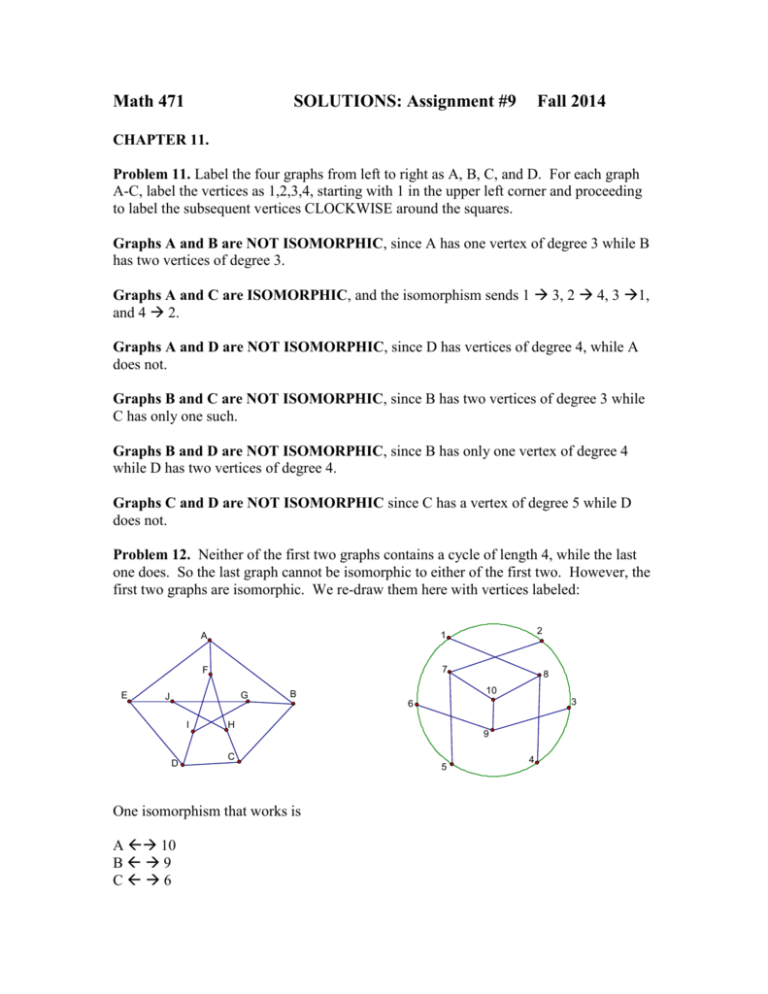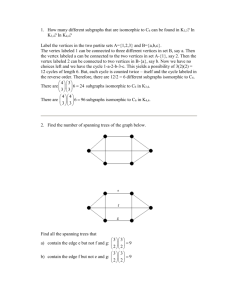HERE - Full-Time Faculty
advertisement

Math 471
SOLUTIONS: Assignment #9
Fall 2014
CHAPTER 11.
Problem 11. Label the four graphs from left to right as A, B, C, and D. For each graph
A-C, label the vertices as 1,2,3,4, starting with 1 in the upper left corner and proceeding
to label the subsequent vertices CLOCKWISE around the squares.
Graphs A and B are NOT ISOMORPHIC, since A has one vertex of degree 3 while B
has two vertices of degree 3.
Graphs A and C are ISOMORPHIC, and the isomorphism sends 1 3, 2 4, 3 1,
and 4 2.
Graphs A and D are NOT ISOMORPHIC, since D has vertices of degree 4, while A
does not.
Graphs B and C are NOT ISOMORPHIC, since B has two vertices of degree 3 while
C has only one such.
Graphs B and D are NOT ISOMORPHIC, since B has only one vertex of degree 4
while D has two vertices of degree 4.
Graphs C and D are NOT ISOMORPHIC since C has a vertex of degree 5 while D
does not.
Problem 12. Neither of the first two graphs contains a cycle of length 4, while the last
one does. So the last graph cannot be isomorphic to either of the first two. However, the
first two graphs are isomorphic. We re-draw them here with vertices labeled:
E
A
1
F
7
G
J
I
D
A 10
B9
C6
8
10
B
3
6
H
9
C
One isomorphism that works is
2
5
4
D5
E7
F8
G3
H1
I4
J2
There are many other possibilities, of course.
Problem 13. Suppose that there is a walk from vertex x to vertex y in a graph G. If the
walk does not visit any vertex more than once, then it is already a path and we have a
path from x to y. If, on the other hand, some vertex v along the walk is visited more than
once, we remove all edges of the walk that occur between the first visit to v and the last
visit to v. This will leave us with a shorter walk that visits vertex v only once. Repeat
this process with any other vertices that are visited more than once by the walk. The
result is a path from x to y.
Problem 19. First note that if G’ is connected, then so is G, because G is obtained from
G’ by adding edges and/or loops between the existing vertices. If there was already a
walk between any two vertices in G’, then this walk still exists after additional edges
and/or loops are added to G’ to get G.
Conversely, deleting multiple edges and loops from the graph of G does not destroy the
existence of a walk between any two given vertices. If there was a walk from vertex x to
vertex y in G, then that walk is still available in G’, because the walk from vertex x to
vertex y can be achieved without using loops and without using more than one edge
connecting any two vertices of the graph.
Note that if G is planar, then since G’ is obtained by deleting edges and/or loops from G,
then G’ is obviously planar as well (removal of edges and loops from G does not create
unavoidable crossings!). Conversely, given G’ planar (without any crossings), we can
always add loops and/or multiple edges between vertices that are already connected
without creating any crossings. For instance, we can make small, concentric loops
around any vertex we want that do not interfere with other edges in the graph. Multiple
edges can be added that are extremely close and parallel to already existing edges so that
they also do not create crossings.
Problem 20. We give a proof by contrapositive.
Suppose that G is a graph of order n that is not connected. We will prove that the number
of edges of G is at most (n-1)(n-2)/2. Since G is not connected, we can separate the
vertex set V into two parts, X and Y, such that no vertex from X is connected to any
vertex in Y. Suppose that |X| = k and |Y| = n-k for some positive integer k. The
maximum number of edges connecting vertices in X is C(k,2) and the maximum number
of edges connecting vertices in Y is C(n-k,2). Thus, the maximum number of edges that
such a graph G could possess is C(k,2) + C(n-k,2) = 0.5k(k-1) + 0.5(n-k)(n-k-1) =
0.5[k2 – k + n2 – 2nk – n + k2 +k] = 0.5[2k2 + n2 – 2nk – n] = k2 – nk + C(n,2) =
C(n,2) – k(n-k) ≤ C(n,2) – (n-1), since k(n-k) is smallest when k=1. But C(n,2)-(n-1) =
(n-1)[n/2 – 1] = (n-1)(n-2)/2. This is what we needed to prove.
To get a disconnected graph of order n with (n-1)(n-2)/2 edges, simply let one vertex be
isolated (degree 0) and form the complete graph Kn-1 on the remaining n-1 vertices.
Problem 21. If G is already connected, then adding new edges to G will preserve the
connectedness of the graph, since one can still take a walk between any two vertices in
the graph by following the edges of the previously existing walk in G. Therefore, G* is
connected.
Conversely, suppose that G* is connected. We wish to show that G is connected. Note
that all vertices of G* have even degree. Therefore, by Theorem 11.2.2, G* has a closed
Eulerian trail. The edge {x,y} is exactly one edge of the closed Eulerian trail, so if we
remove this edge, we can still take a walk from x to y by walking around the Eulerian
trail in the opposite direction (the long way around!). Therefore, removal of {x,y} has
not prohibited us from walking between edges x and y, and thus, all vertices of G can still
be joined along a walk. Therefore, G is connected.
Problem 29. The first graph has four vertices of odd degree, so it has neither an open nor
closed Eulerian trail. The second graph has all vertices of even degree, so it has a closed
Eulerian trail (by Theorem 11.2.2). We reproduce the figure below, with vertices
labeled:
D
A
B
C
E
F
G
I
J
H
K
One example of a closed Eulerian trail would be
A B C H C G H K J K G B A D I D E
I J G F J E F B E A.
Problem 30. Recall that the degree of each vertex of Kn has degree n-1. For a graph to
have a closed Eulerian trail, every vertex must have even degree. Thus, n-1 must be
even. Hence, n must be odd. The only complete graph that has an open Eulerian trail is
K2, since this is the only complete graph with exactly two vertices of odd degree (both of
them have degree 1).
Problem 34. Omitted.









